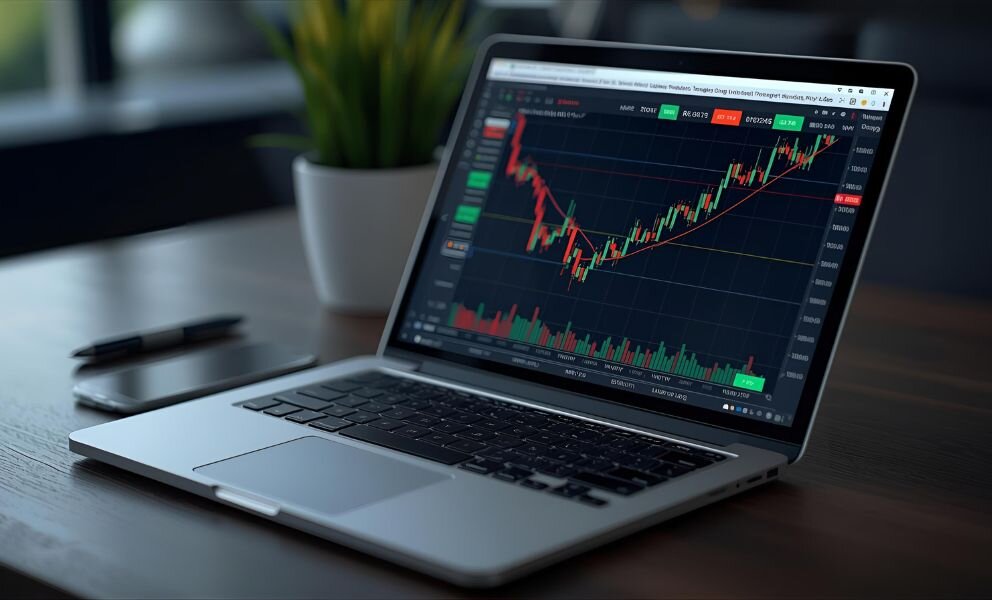
What is CFD trading? A beginner's guide
* Trading is risky. Your capital is at risk.
Key takeaways
CFD stands for Contract for Difference - a form of derivative trading
CFDs let you trade price movements without owning the underlying asset
CFDs also let you go 'long' or 'short', offering opportunities in both rising and falling markets
CFDs are often traded with leverage - it's vital you manage your risk
CFDs are popular financial instruments which are key components of a trader’s portfolio.
However,for traders at the start of their trading journey – it can be difficult to fully understand the advantages and disadvantages of investing in and trading CFDs.
In this guide, we will be taking a balanced look at trading CFDs, giving you access to all the information you need to decide whether it’s the right instrument for you.
What are CFDs?
The term CFD stands for C"ontract For Difference" - a type of trading instrument and a popular gateway for investors to enter the financial markets.
CFDs are offered by brokers alongside other assets like forex, commodities and spot metals. Unlike these however, CFDs are a form of derivative trading. This means that they derive their value from the movement of an underlying asset.
Engaging in a contract
When traders choose to trade CFDs, it means that they are engaging in a contract between themselves and the broker.
The trader – the “buyer” – and the broker – the “seller” – agree to a contract which speculates on the price of an asset in market conditions. While the trader speculates on financial instruments, it is important to note the main distinction between CFDs and traditional trading.
CFDs allow traders to trade price movements without actually owning the underlying asset. By not owning the underlying asset, CFD traders can avoid some of the disadvantages and costs of traditional trading.
What is CFD trading?
So, how exactly does this contract work?
Essentially, profit and loss are calculated by looking at the difference in price between when a contract is entered and when it is exited.
That means that the broker – or ‘seller’ – who enters into this contract with you will pay you the difference between the price at the beginning of the contract and the price at the end. If a loss is made, the trader – “buyer” – will pay the broker the difference.
The key calculation to work out your profit or loss is: the difference between the price at which you enter and the price when you exit, multiplied by your number of CFD units. CFDs are available across a huge range of markets.
With FXTM for example, CFD traders can choose from CFDs on shares, indices, commodities and more. enjoying several advantages over trading these instruments directly.

How to trade CFDs
Trading CFDs with an experienced broker is a simple process. Once you have opened your trading account, you’re just a few steps away from selecting your instrument and starting to trade.
Don’t forget – you can always try out your CFD trading preferences using a Demo account to ensure you’re comfortable with your chosen instrument before you enter the live markets.
Choose your instrument
Between stock CFDs, index CFDs and commodity CFDs, choosing your underlying asset is an important choice. Not sure which to choose? Check out our beginner’s guide to forex trading for a broad overview of the underlying assets you can choose from.
Alternatively, discover which markets are hitting the headlines by following the latest market analysis reports and videos.
You can discover the particular specifics of each CFD by visiting a broker’s contract specifications page, where you can find out about instrument leverage specifics and competitive trading costs.
Choose your position
Once you’ve decided what kind of CFD you’re going to trade, it’s time to decide on your position.
Put simply, if you think the price of your asset will go up you can open a long position (buy), or if you think the price will fall you could open a short position (sell).
To decide what kind of trade you want to open, you can use a broad range of indicators, charts and signals. To find out more about popular strategies and indicators, you can visit our forex strategies guide.
Next, choose the size of the position you want to open. The value of a unit of the CFD you’re trading will depend upon the instrument, so you should calculate the number of CFD units that can work best with your trading strategy.
Choose your platform
CFDs can be traded on the industry’s most popular trading platforms, including MetaTrader 4 (MT4) and MetaTrader 5 (MT5). These platforms are equipped with all the tools you need to trade CFDs, including over 50 technical indicators and charting tools.
You can also trade on mobile apps, allowing you to keep track of your profits and losses in real-time, on-the-go.
CFD margin and leverage
Margin and leverage are important considerations when trading CFDs.
One of the key advantages of CFD trading is that you only need to deposit a small percentage of the total trade value. FXTM CFD traders only require a margin starting from 3 percent. FXTM’s margin calculator is a useful tool to help you to manage your margin on the FXTM Standard account.
Leverage is higher with CFDs than with traditional trading.
Traders use a smaller portion of their own capital when opening a position, which allows for potentially bigger returns. That said, it’s important to remember that leverage carries the same potential to increase losses as it does to boost profits.
What CFD markets can I trade?
Enter the markets with FXTM to trade CFDs on a range of instruments. With FXTM you can trade:
| Commodity CFDs | Indices CFDs | Stock CFDs | Future CFDs | ETF CFDs | Crosses CFDs |
|---|---|---|---|---|---|
Brent oil | S&P 500 | Tesla | S&P 500 future | ARK Innovation ETF | S&P 500 vs Japan 225 |
Crude oil | Nasdaq 100 | Apple | Nasdaq 100 future | iShares Emerging Markets ETF | Wall Street 30 vs Gold |
Copper | US dollar index | Nvidia | US 30 future | SDPR S&P 500 Value ETF | Brent Oil vs WTI Crude Oil |
... and many more. You can view our full market availability here.
Choosing your CFD trading platform
MT4 and MT5 are complete with the latest charts and tools to help you advance your CFD trading strategy.
With FXTM, you can use the industry’s most popular platforms to trade CFDs across shares, indices, commodities. MetaTrader is complete with updated tools to give you a smooth, user-friendly CFD trading experience.
You can also trade from your mobile with FXTM trading app. This revolutionary investment app enables you to access the markets from the palm of your hand, wherever you go. Download today to manage your trades in seconds, view your trading accounts and access live currency rates.
Choosing a CFD broker
When it comes to choosing a broker to trade CFDs with, it’s important to make the right choice. Traders should look for brokers who are regulated, secure and experienced, including award-winning brokers like FXTM.
History of CFD brokers
CFD providers give traders access to the online markets with varying margin requirements, account types and trading platforms. The instrument has only been available to retail clients since the late 1990s. However, they quickly picked up momentum.
Online CFD providers opened the door to a host of new possibilities for traders, including adding derivatives to their portfolio. Today its estimated that 21% of traders have traded CFDs.
Why trade CFDs with FXTM?
- Wide range of trading instruments
- Unparalleled trading conditions
- Globally licensed and regulated
- Committed to forex education
- Tools for novices and experts alike
Benefits and risks of trading CFDs
Higher leverage
Brokers typically offer CFDs with higher leverage than other traditional financial instruments. FXTM offers a leverage up to 1:3000 which can boost traders’ potential profits. The lower margin requirements of CFDs mean that potential returns are greater overall – however, traders should bear in mind that leverage can boost losses as well as profits.
Go long and short
CFDs grant traders the ability to go both long and short on instruments. Since the underlying asset isn’t actually owned, traders have greater flexibility and can open short positions on CFD trading instruments without worrying about additional costs.
Range of trading opportunities
Most brokers offer CFDs on a wide range of markets. You can enter the commodity, indices, stocks and metal markets with FXTM and trade these assets as CFDs, enjoying the opportunities and advantages associated with each.
Cost of spreads
Although CFDs spare traders from many of the costs of traditional trading, CFD traders are required to pay the costs of spreads. CFD traders have to pay the spread on entry and exit positions, meaning that it’s potentially harder to make small profits. The spread cost must be factored into the calculated profits and losses resulting from CFD trading.
The good news here is that the FXTM Advantage account offers typically zero spreads on FX majors and as low as zero on Gold, which are CFD products.
Risks
CFDs do not come without risks. Trading these instruments can be risky and fast–paced, and traders should be careful to have a thorough risk–management strategy in place. Placing stop–loss orders can potentially help to minimise potential losses, but do not eliminate the risks altogether.

Popular CFD trading strategies
Swing trading
With swing trading you’re looking at assets that will likely have short-term price moves you can exploit. Leaving your position overnight attracts more risk because of the potential for unexpected events to affect the market.
Day trading
As the name suggests, day traders open and close trades over the course of the day, usually holding positions for only a few hours. Day trading removes the risk that occurs when you leave a position open overnight.
Scalp trading
Scalp traders aim to make very small, very frequent profits. They typically only hold positions for a few seconds or minutes and exploit small opportunities while they trade with the prevailing trend.
Frequently asked questions
CFD stands for "Contract For Difference" - a type of trading instrument and a popular gateway for investors to enter the financial markets.
They are offered by brokers alongside other types of common assets like forex, commodities and spot metals. Unlike these however, CFDs are a form of derivative trading. This means that they derive their value from the movement of an underlying asset.
Tax laws are subject to change and depend on individual circumstances. Tax law may differ in your jurisdiction.
At FXTM, we believe that a successful trader is an educated trader.
Traders who gain a solid understanding of the markets and create a thoroughly researched trading strategy are likely to be more prepared to take on the live markets.
That’s why it’s important for traders to make the most out of educational resources to help them build their own personalised trading strategy.
It’s particularly important to create a strategy in order to minimise the impact emotions have on important trading decisions.
The bottom line
CFD trading offers flexibility, leverage, and the ability to profit from both rising and falling markets, but it also carries significant risk.
By understanding how CFDs work, managing costs, and applying solid risk-management strategies, traders can make more informed decisions. Choosing a regulated broker is essential to ensure a safe and reliable trading experience.

